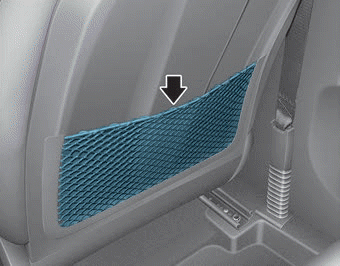Hyundai Ioniq: With Tire Mobility Kit (TMK) - Type B / Components of the Tire Mobility Kit

1. Speed restriction label
2. Sealant bottle and label with speed restriction
3. Filling hose from sealant bottle to wheel
4. Connectors and cable for power outlet direct connection
5. Holder for the sealant bottle
6. Compressor
7. ON/OFF switch
8. Pressure gauge for displaying the tire inflation pressure
9. Button for reducing tire inflation pressure
Connectors, cable and connection hose are stored in the compressor housing.
Strictly follow the specified sequence, otherwise the sealant may escape under high pressure.
WARNING
Do not use the tire sealant after the sealant has expired (i.e. pasted the expiration date on the sealant container). This can increase the risk of tire failure.
WARNING
- Keep out of reach of children.
- Avoid contact with eyes.
- Do not swallow.
 Notes on the safe use of the Tire Mobility Kit
Notes on the safe use of the Tire Mobility Kit
Park your car at the side of the road so that you can work with the Tire
Mobility Kit away from moving traffic.
To be sure your vehicle will not move, even when you're on fairly level
ground, always set your parking brake...
 Using the Tire Mobility Kit
Using the Tire Mobility Kit
CAUTION
Detach the speed restriction label (1) from the sealant bottle (2), and place
it in a highly visible place inside the vehicle such as on the steering wheel to
remind the driver not to drive too fast...
Other information:
Hyundai Ioniq (AE) 2017-2025 Owner's Manual: Repairing your vehicle’s finish, Bright-metal maintenance
Repairing your vehicle’s finish Deep scratches or stone chips in the painted surface must be repaired promptly. Exposed metal will quickly rust and may develop into a major repair expense. NOTICE If your vehicle is damaged and requires any metal repair or replacement, be sure the body shop applies anti-corrosion materials to the parts repaired or replaced...
Hyundai Ioniq (AE) 2017-2025 Service Manual: Sunroof Guide. Repair procedures
Replacement1.Remove the sunroof assembly.(Refer to Sunroof - "Sunroof Assembly") 2.Remove the sunroof sunshade.(Refer to Sunroof - "Sunroof Sunshade") 3.Down the slide by pushing it and then remove the drip link assembly (A).4.Separate the drip link (B) and guide (A)...
Categories
- Manuals Home
- 1st Generation Ioniq Owners Manual
- 1st Generation Ioniq Service Manual
- Towing
- Auto Door Lock/Unlock Features
- Tilt Steering / Telescope Steering
- New on site
- Most important about car
Seatback pocket

The seatback pocket is provided on the back of the front passenger's seatback.
WARNING
To prevent the Occupant Classification System from malfunctioning:
